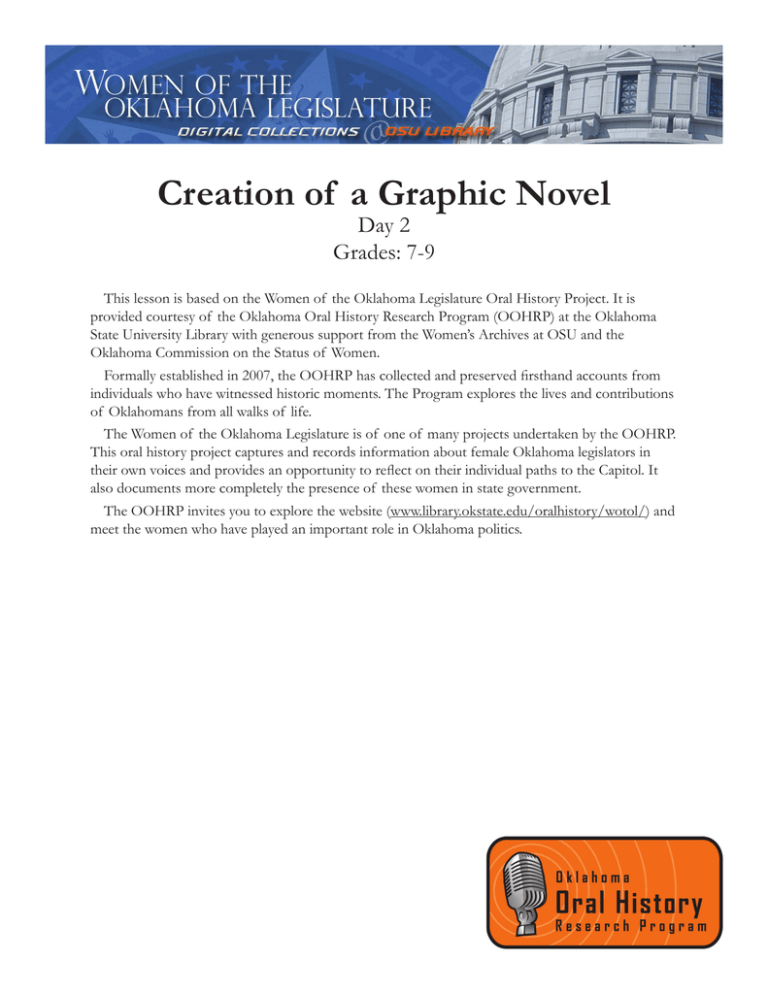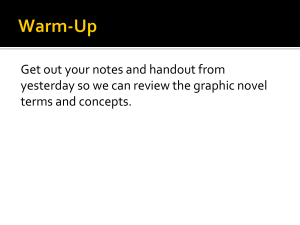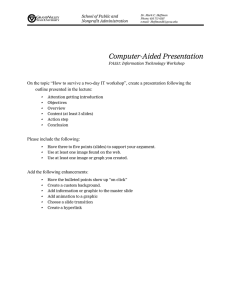Creation of a Graphic Novel Day 2 Grades: 7-9
advertisement

Creation of a Graphic Novel Day 2 Grades: 7-9 This lesson is based on the Women of the Oklahoma Legislature Oral History Project. It is provided courtesy of the Oklahoma Oral History Research Program (OOHRP) at the Oklahoma State University Library with generous support from the Women’s Archives at OSU and the Oklahoma Commission on the Status of Women. Formally established in 2007, the OOHRP has collected and preserved firsthand accounts from individuals who have witnessed historic moments. The Program explores the lives and contributions of Oklahomans from all walks of life. The Women of the Oklahoma Legislature is of one of many projects undertaken by the OOHRP. This oral history project captures and records information about female Oklahoma legislators in their own voices and provides an opportunity to reflect on their individual paths to the Capitol. It also documents more completely the presence of these women in state government. The OOHRP invites you to explore the website (www.library.okstate.edu/oralhistory/wotol/) and meet the women who have played an important role in Oklahoma politics. Creation of a Graphic Novel-Day 2 Oklahoma PASS Objectives • Visual Arts 3:1 Use observation, memory and imagination in making original works of art. (Grades 7 and 8) • Visual Arts 3:1 Create original two-and three-dimensional works of art from observation, memory and imagination using a variety of art media. (Grade 9/High School) • Visual Arts 4:2 Demonstrate respect for personal artwork and the artwork of others. (Grades 7, 8 and 9) • Visual Arts 4:3 Demonstrate thoughtfulness and care in completion of artworks. (Grades 7, 8 and 9) Lesson Objective The students will utilize research information from yesterday’s lesson to create a graphic novel or cartoon or comic strip based on the life and accomplishments of one of the women who has served as an Oklahoma senator or representative. Lesson As you recall, yesterday you collected information on the life of one of the women who has served in our Oklahoma Legislature. This woman was either a senator or a member of the House of Representatives. Today you will begin a project to create a graphic novel about the woman whom you researched. It may take us a few days to complete our graphic novels. When we have completed our projects, we will brainstorm about ways in which we can share our information. We have been studying the Oklahoma House of Representatives and the Oklahoma Senate. You will remember that today there are 101 members of the House of Representatives and 48 members of the Senate. We are going to learn about the women who have served in our Legislature. The information that we are researching today is biographical information. Yesterday we discussed biographies. You shared with the class your favorite biographies. (If few of the biography topics were male, bring out that point. This project will be about women.) Have you ever seen a biography that was in cartoon format? (If possible have the two historical graphic novels to show the students as examples.) Cartoons are set in “frames”. (Use a bulletin board as an example. It is “framed” with some visual material in the inside area.) Other than a bulletin board, what other examples could we use to describe cartoons? The cartoons are put together on the page. How many cartoons are on one page? (As many as you wish.) Because you are the designer and artist for this cartoon, you decide the layout of your page. Can you have more than one page? Yes, if you need more than one page, please design your cartoon to fit on two pages. Specifically you will have TEN frames. You can have five frames per page if you wish. Let’s try to keep our cartoons to a maximum of two pages please. www.library.okstate.edu/oralhistory/wotol/ 2 Creation of a Graphic Novel-Day 2 Whole group instruction: What are the components of a cartoon? • The image Will it be a large image or a minimized image? • The text explaining the image Will it go at the bottom or at the top of the frame? • Dialogue You can use “balloons” to show that a person is speaking. In Microsoft Word, they are referred to as “call outs” Show samples of balloons or call outs Thinking—you can use balloons or callouts to show what the person is thinking Notice the differences between “thinking” and “speaking”. (The teacher will point out the difference if the students do not grasp the difference.) You will have TEN frames for your biography. We could refer to this as a “comic strip” because we will connect the frames together. Because the pictures within the biography are “graphics”, we will refer to them as “graphic novels”. The teacher will pass out the Senator/Representative Information Sheet that was completed yesterday. Ask the students to take out two sheets of notebook paper. After looking at the questions on the Graphic Novel Information Sheet, ask the students to begin to sketch the frames of their graphic novels. Remember to leave space somewhere for a TITLE and ENDING. *The teacher needs to decide if the pages will be set up as LANDSCAPE or PORTRAIT. That is, will they run up and down (Portrait) or will they be laid out horizontally (Landscape)? This is important because your class will not be able to complete the Enrichment suggestions if there is not a standard page design. Specifically tell the students what the page set up will be. They can then use rulers to sketch out their frames. If they do not have rulers available, they can take a sheet of notebook paper and fold it once lengthwise, then fold it again lengthwise, pinch well to create a good crease. They can then use the folded side as their straight edge. After sketching out their frames, the students can begin to sketch out their contents for each frame. They will use the Senator/Representative Information Sheet as their reference. www.library.okstate.edu/oralhistory/wotol/ 3 Creation of a Graphic Novel-Day 2 Depending on the abilities of your class, you can encourage them to use only pencil at first, then add color OR begin with markers and ink pens. This portion of the lesson will take more than one class period to complete. Please tell the students specifically what you want them to have completed tomorrow, the next day, etc. By stating your expectations, the students will then know what is to be completed each day. Some teachers may not want the work to be taken out of class because others may add their artistic abilities to the project. Decide in advance if this is a “totally in-class project” or if it can be taken home at night. Evaluation Design a rubric that includes twelve parts—the ten frames of the comic and also the Title and Ending. You can designate the number value you wish each component to have. You may wish to have the Title and Ending worth less than the other parts. You may wish to weight the three parts that the students chose as a higher point value. Because this assignment will take more than one class period to complete, consider giving it a higher total point value than a regular single-class assignment. Materials Student Supplies • Plain photocopy paper--legal sized or ledger sized if possible • Pencils, markers, crayons, ink pens Possible Teacher Resource Two great resources for historical graphic novels are: The Cartoon History of the Modern World: Part 1 From Columbus to the U. S. Constitution, by Larry Gonick, New York: Collins, 2007. The Cartoon History of the United States, by Larry Gonick, New York: Harper Perennial, 1991. Enrichment Language Arts • Take the information gathered from each specific individual and design a “Living Museum”. Invite a class or group of classes to visit your classroom. Your students will become the individual they researched. They will speak in “first person”. (For example, “I am Mrs. Lamar Looney. I was born ...”) The students remain silent until someone touches their elbow or shoulder or a specific designated location. They then will give their first-person presentation. • Scan each graphic novel, print out colored copies, and create a class book consisting of all the biographies completed. Technology • Scan each graphic novel and create a PowerPoint slide show of all the biographies. The students can create a “cover slide” to go before their particular work. They can also add background, such as our state song, to go along with the slide show. Be sure to set your “delay” longer than the usual five seconds. This will allow the viewers to see the images longer and gather more information. Notes for Teacher Refer to notes from Day 1 of this lesson plan. www.library.okstate.edu/oralhistory/wotol/ 4



